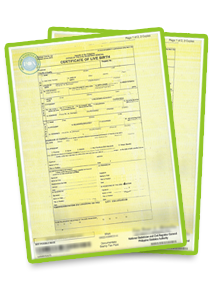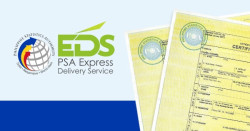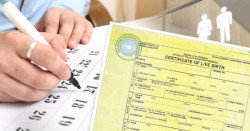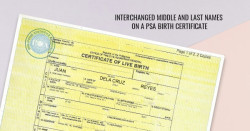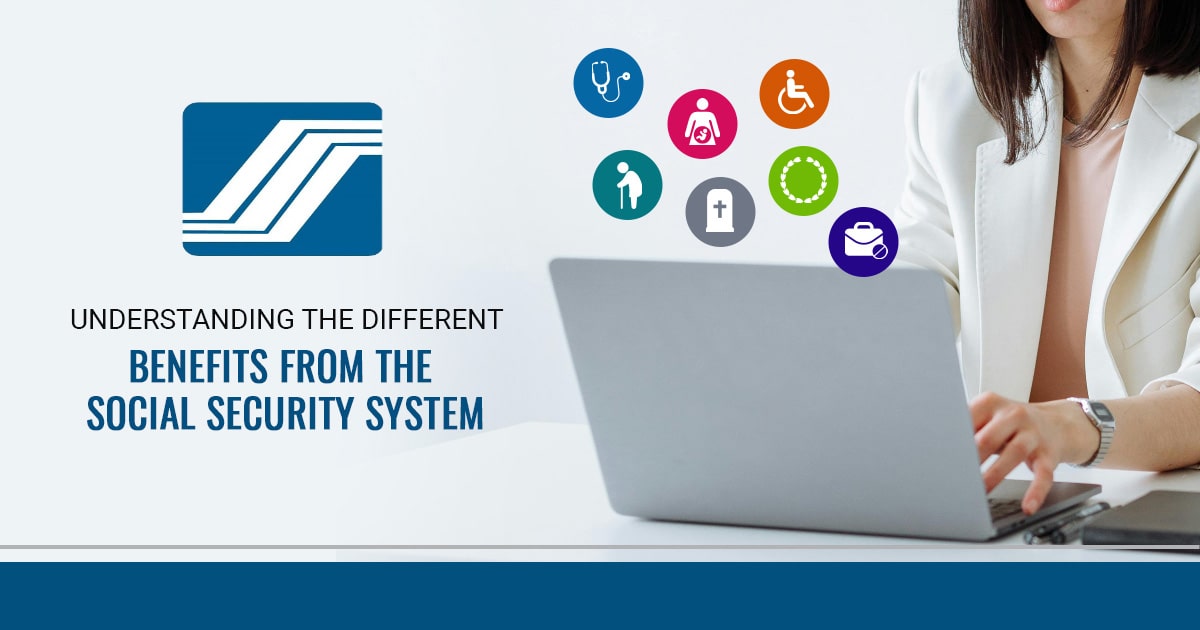
The Social Security System (SSS) serves as a vital lifeline for Filipinos, providing financial support at various points in life. This support system aims to ease the financial strain that could emerge during difficult circumstances, guaranteeing that individuals and their families can obtain necessary assistance. Understanding the importance of your contributions is key, as they lay the groundwork for future benefits like retirement and disability assistance.
Table of Contents
Step-by-step guide to ordering your PSA birth certificate online
Step-by-Step Guide: How to Create and Use Your My.SSS Account
What are the benefits of having SSS?
The Social Security System (SSS) is a government-run institution designed to provide financial security for Filipino workers. By becoming a member of the SSS, individuals gain access to a comprehensive range of benefits that can significantly impact their financial well-being. These benefits are carefully crafted to address various life stages and unforeseen circumstances. From retirement to sickness, disability, and death, the SSS offers a safety net that can provide much-needed support. In the following sections, we will delve into the key benefits that SSS members are entitled to, highlighting their significance and eligibility criteria.
-
Sickness Benefit
- Provides a daily cash allowance for the duration of the member’s sickness, allowing them to recover without worrying about lost income.
- Covers both sickness and disability, ensuring financial support for members facing health challenges.
-
Maternity Benefit
- Offers a daily cash allowance to female members who are unable to wok due to pregnancy, childbirth, or miscarriage.
- Eases the financial burden during maternity leave, providing much-needed support for new mothers.
-
Disability Benefit
- Provides a monthly pension or lump sum amount to members with permanent or temporary disabilities.
- Helps individuals who experience limitations in their physical or mental abilities, ensuring financial stability despite their condition.
-
Retirement Benefit
- Grants a monthly pension or lump sum payment to retired members, allowing them to enjoy a comfortable life after years of service.
- Provides financial security during retirement, enabling members to maintain their standard of living.
-
Death Benefit
- Offers a monthly pension or lump sum to the beneficiaries of deceased SSS members, providing support during difficult times.
- Helps alleviate financial strain for loved ones left behind, ensuring their well-being in the absence of the member.
-
Funeral Benefit
- Provides financial assistance to cover the funeral and burial expenses of deceased SSS members.
- Eases the financial burden of the family or individual who incurred the costs, allowing them to focus on honoring their loved one’s memory.
-
Unemployment Benefit
- Extends support to employees who lose their jobs due to circumstances such as retrenchment, redundancy, or company closure.
- Available to private employees, household workers (kasambahay), and overseas Filipino workers (OFWs), offering a safety net during periods of unemployment.
Overview of SSS Membership Types
The Social Security System (SSS) caters to a variety of membership categories, each with specific contribution rules and benefit qualifications. Understanding your membership type can help you navigate the benefits you are entitled to more effectively.
- Employed Members: Those working in private companies or establishments with regular employment. Contributions are typically shared between the employee and employer.
- Self-Employed Members: Individuals running their own business or earning income independently, such as freelancers and professionals. They are responsible for paying their contributions directly to the SSS.
- Voluntary Members: Those who are not formally employed or self-employed but want to maintain SSS membership and avail of benefits, such as retirees or housewives.
- Overseas Filipino Workers (OFWs): Filipinos working abroad who maintain contributions with the SSS to ensure continued social protection.
- Non-Working Spouse: A married spouse who is not employed but is included in the membership of their working partner.
Each membership type has its own contribution schedules and eligibility criteria for benefits, so it is important to know which category you belong to when planning your SSS transactions.
Why Keeping Your Records Updated is Crucial
Accurate and updated records with the SSS are essential to avoid delays or denials in benefit claims. One common issue faced by many members is discrepancies in their personal information, especially name spellings, birthdates, or missing details. Such inconsistencies often stem from outdated or incorrect civil registry documents.
For example, your PSA birth certificate is often required to validate your identity and confirm your eligibility for certain benefits. Errors or missing information in your birth certificate can result in complications when filing claims.
Fortunately, you can easily order a PSA birth certificate online through trusted platforms like PSAHelpline.ph. This service offers birth certificate delivery right to your home or at nearby pickup locations, saving you time and effort.
Step-by-step guide to ordering your PSA birth certificate online:
- Visit PSAHelpline.ph.
- Click the “Order Now” button and fill out the application form with your personal details.
- Choose your preferred delivery method: home delivery or pick-up at select National Book Store and Robinsons Department Store branches.
- Proceed with payment through secure channels.
- Track your order until it arrives.
Keeping your civil registry documents updated and accessible will help you file your SSS claims smoothly and without unnecessary delays.
Step-by-Step Guide: How to Create and Use Your My.SSS Account
The My.SSS online portal is your gateway to accessing and managing your SSS benefits conveniently. Instead of going to a branch, many transactions including benefit claims, loan applications, and contribution payments can be done online.
How to register for a My.SSS account:
- Visit www.sss.gov.ph.
- Click on “Not Registered? Create an Account.”
- Provide your Social Security Number (SSS number), birthdate, and other required details.
- Set up your username, password, and security questions.
- Confirm your registration via email.
Using My.SSS for benefit claims:
- Log in to your account anytime and select “E-Services.”
- Choose the appropriate benefit application such as Sickness, Maternity, or Retirement Benefit.
- Upload scanned documents including your PSA birth certificate if required.
- Track your claim status online for updates.
- Enroll in a disbursement account (bank, e-wallet, or UMID-linked ATM) for faster benefit payments.
Filing your claims through My.SSS not only saves you time and travel expenses but also helps you keep track of your application status without the need for follow-ups.
SICKNESS BENEFIT

Who is qualified for SSS Sickness Benefits?
To be eligible for this benefit, a member must:
- Be unable to work due to illness or injury, requiring confinement at home or in a hospital for a minimum of four days.
- Have made at least three months’ worth of contributions within the 12-month period preceding the semester of illness or injury.
- Have promptly informed the SSS about the illness or injury.
How to Claim SSS Sickness Benefit
Here is how to file a Sickness Benefit claim at the SSS based on membership status:
- For SELF-EMPLOYED, VOLUNTARY, OFW, NON-WORKING SPOUSE, and those SEPARATED FROM EMPLOYMENT: Visit the nearest SSS office to file your claim
- Employed members can file directly through their HR department
What are the documents needed for SSS Sickness Benefit?
Documentary Requirements for Sickness Benefit application:
- Duly accomplished Sickness Benefit Application form (SBA)
-
SSS ID or UMID card or any of the following valid primary IDs:
- Driver’s license
- Passport
- Voter’s ID
- NBI clearance
- Postal ID
- Any other government-issued ID
-
Supporting medical documents:
- Laboratory
- Xray
- ECG
- Other diagnostic results
- Operating room or clinical record that will support diagnosis
If the member is filing for the sickness benefit personally, they should bring any of the primary IDs listed above OR two secondary IDs, each containing a signature, with at least one featuring a photo.
If the member sends an authorized representative to file on their behalf, they should ensure the representative brings one of the member’s valid primary IDs along with one of the authorized representative’s IDs, or two secondary ID cards, each with a signature, and at least one with a photo. Ideally, the representative should carry an authorization letter from the member if possible.
How long do I have to claim SSS Sickness Benefit?
Prescriptive Period in the Filing of Sickness Benefit Claim
- Home Confinement – The Sickness Benefit Application form must be submitted within five calendar days after the start date of confinement.
- Hospital Confinement – The Sickness Benefit Application form must be submitted to the SSS within one year from the date of hospital discharge.
Filing for sickness benefits after the deadline may lead to a reduced claim or even denial. If the filing deadline falls on a weekend or holiday, submit the claim to the SSS by the next working day to avoid being considered late. Any submissions after this grace period will be deemed late.
How to claim approved SSS Sickness Benefit?
Disbursement Procedure
If the member has a Unified Multi-purpose Identification (UMID) card linked to an ATM, the sickness benefit will be deposited into their UMID account. If not, payment will be processed through participating banks like the Development Bank of the Philippines (DBP) via PESONet, e-wallets, or accredited remittance transfer companies and cash payout outlets. To receive the proceeds, the member must have a My.SSS account and properly enroll either PESONet or e-wallet account there.
MATERNITY BENEFIT
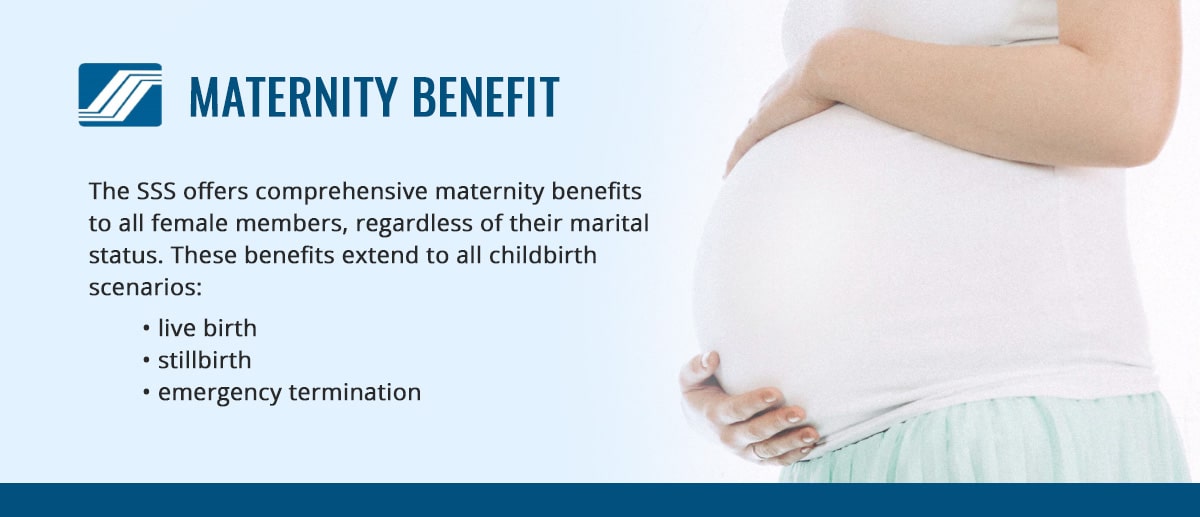
The SSS offers comprehensive maternity benefits to all female members, regardless of their marital status. These benefits extend to all childbirth scenarios: live birth, stillbirth, or emergency termination.
To qualify for the SSS maternity benefit, the member must have paid at least three months of contributions within the 12-month period immediately before the semester of childbirth (or miscarriage, or emergency termination).
Like the process for claiming sickness benefits, employed members are required to inform their employer of their pregnancy. Conversely, those who are separated from employment, self-employed, voluntary members, and Overseas Filipino Workers (OFWs) must directly notify the SSS regarding their pregnancy.
How do you qualify for SSS maternity benefits?
A female member qualifies for this benefit if she meets the following conditions:
- She has paid at least three months’ worth of contributions in the 12 months leading up to the semester of childbirth, miscarriage, or ETP. Only contributions paid before the semester of the contingency will be considered for eligibility.
- If employed, she must inform her employer of her pregnancy and expected delivery date. This information must be transmitted to the SSS as per their guidelines.
- If self-employed, a voluntary member, a non-working spouse, or an OFW, she must directly notify the SSS of her pregnancy and estimated due date.
What documents are needed to apply for maternity benefits?
-
For live childbirth (normal or caesarian) ANY OF THE FOLLOWING:
- Child’s Certificate of Live Birth (CLB)/ Certificate of Death (COD) duly registered with the Local Civil Registrar (LCR) with corresponding Official Receipt or Acknowledgment Receipt (AR) issued by the LCR, if the filing date of MBA/MBRA is within six months from the date of delivery; OR
- Child’s PSA birth certificate/PSA death certificate with corresponding OR or AR if the filing date of MBA/MBRA is beyond six (6) months from the date of delivery, or
- Report of Child’s Birth/Death issued by the Philippine Embassy/Consulate General/PSA, or its equivalent document issued in a foreign country with English translation, if applicable.
-
For stillbirth or fetal death – ANY OF THE FOLLOWING:
- Certificate of Fetal Death (COFD) duly registered with the LCR with corresponding OR or AR issued by the LCR. If filing date of MBA/MBRA is within six months from the date of delivery; OR
- PSA death certificate with corresponding OR or AR if filing date of MBA/MBRA is beyond six months from the date of delivery; OR
- COFD issued by the Philippine Embassy/Consulate General/PSA, or its equivalent document issued in a foreign country with English translation, if applicable.
-
For miscarriage, emergency termination of pregnancy (ETP), ectopic pregnancy – the following documents shall be required for submission:
-
Any of the following proofs of pregnancy:
- Result of pregnancy test duly signed by a physician/municipal health officer; or
-
Result of other diagnostic tests with the corresponding report duly signed by a physician, which may include any of the following:
- Ultrasound
- Blood pregnancy test (Beta HCG); or
- Early pregnancy factor
-
Any of the following proofs of termination of pregnancy duly signed by a physician:
- Pregnancy test result
- Ultrasound result
- Histopathological report
- Operating Room Record (ORR)
-
Any of the following medical documents duly signed by a physician:
- Medical Certificate
- Records of Consultations; or
- Clinical Abstract/Discharge Summary
-
How can I extend my maternity leave in the Philippines?
The Expanded Maternity Leave Law or RA 11210 offers several important provisions for expectant mothers:
- Duration: Mothers are entitled to 105 days of leave for childbirth, regardless of whether it is a normal delivery or a caesarean section.
- Optional Additional Leave: An additional 30 days of leave is available for mothers who choose to extend their time off.
- Solo Parent Benefit: Solo parents under RA 8972 can receive an extra 15 days of paid leave
- Miscarriage or Emergency Termination: In cases of miscarriage or emergency termination of pregnancy, mothers are eligible for 60 days of paid leave.
- Parental Sharing: Mothers have the option to share 7 days of their maternity leave benefits with the child’s father, regardless of their marital status.
- Benefit Limit: While there’s no limit on the Expanded Maternity Leave duration, only one benefit can be claimed per pregnancy, regardless of the number of babies born.
These provisions aim to support mothers during the crucial period of childbirth and recovery, ensuring they have the necessary time and resources to care for themselves and their newborns.
DISABILITY BENEFITS
The Disability Benefit is a financial aid, either a monthly pension or a lump sum, provided to members who become permanently disabled, either partially or totally.
Who is eligible for SSS disability?
Individuals who experience partial or total permanent disability and have made at least one monthly contribution to the SSS before the semester of the disability may be eligible for this benefit.
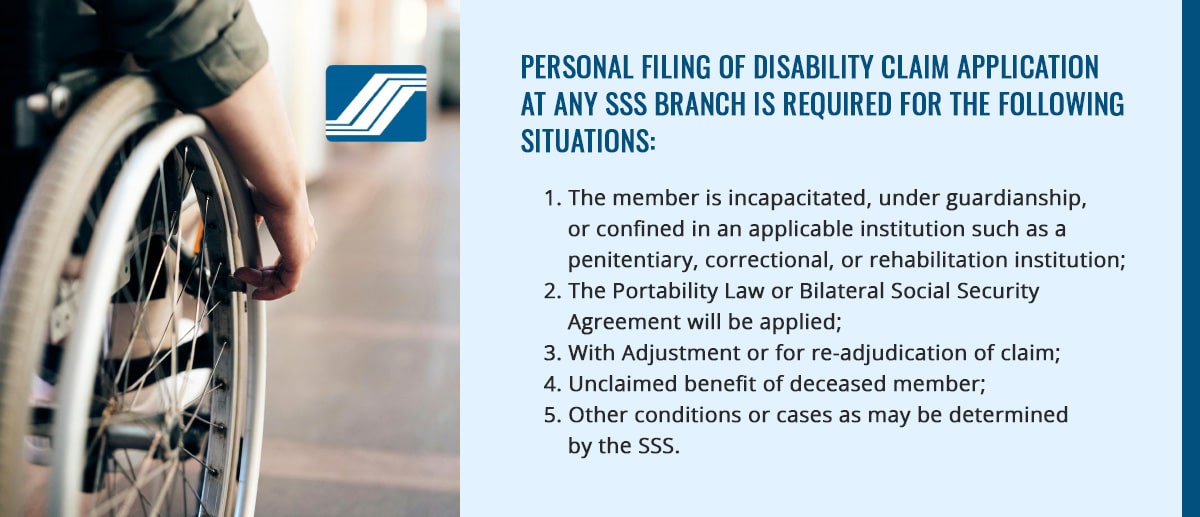
Can I apply for SSS disability online?
Disability benefit claims must be filed at any SSS branch within 10 years of the disability occurrence. In cases where a Medical Specialist is unavailable, a Senior Clerk or Junior Nurse will accept and screen the application and advise the claimant to monitor the claim status online. The Medical Specialist may conduct further verification and a physical examination through field service.
Personal filing of DCA at any SSS branch is required for the following situations:
- The member is incapacitated, under guardianship, or confined in an applicable institution such as a penitentiary, correctional, or rehabilitation institution;
- The Portability Law or Bilateral Social Security Agreement will be applied;
- With Adjustment or for re-adjudication of claim;
- Unclaimed benefit of deceased member;
- Other conditions or cases as may be determined by the SSS.
Disability Benefit Applications will undergo evaluation and the filing member may be required to submit themselves for physical examination and interview at any SSS branch. Failure to comply to the required examination may result in rejection of application. The SSS will coordinate with the member through email that is why it is important to provide a working email that the member can easily access.
What are the requirements for SSS disability claim?
To apply for a Disability Benefit:
- Disability Claim Application (DisCA) Form –This form can be downloaded from the SSS website and needs to be completed by the applicant.
- Member Identification –Bring your original SSS ID, Unified Multi-Purpose ID (UMID), or any valid government-issued ID like a passport, driver’s license, voter’s ID, NBI Clearance, postal ID, or National ID.
- Medical Documentation:
- Member’s/Claimant’s Photo and Signature Form –This form is typically provided by the SSS branch during the initial claim application.
- SSS Medical Certificate Form –This form needs to be completed by your attending physician within six months of filing the claim.
- Supporting Medical Records –Provide certified true copies of any medical records that support your disability claim.
RETIREMENT BENEFIT
The Retirement Benefit is a monetary allowance granted to qualified members who have reached retirement age and are unable to continue working. This benefit can be disbursed either as a regular monthly pension or a one-time lump sum payment.
- Monthly pension – This is a regular cash payment given to retirees for life.
- Lump sum amount – This is a one-time payment equal to the total contributions made by the member, including earned interests.
Who is eligible for SSS retirement?
To qualify for retirement benefits, a member must have paid at least 120 monthly contributions before the semester of retirement. The specific requirements are as follows:
-
For optional retirement:
- At least 60 years old and no longer employed, or has ceased to be self-employed, OFW, or household helper.
- At least 55 years old and no longer employed, or has ceased to be self-employed, if an “underground mineworker”.
-
For technical retirement:
- At least 65 years old, regardless of employment status.
- At least 60 years old, whether still employed or not, if an “underground mineworker”.
- A total disability pensioner who has recovered from disability and is at least 60 years old (or at least 55 years old, if an underground mineworker).
Additionally, a former retiree-pensioner whose monthly pension was suspended due to re-employment or self-employment and is now separated from employment or has ceased to be self-employed can apply.
Moreover, a member aged 60 and above, but not yet 65, with 120 or more contributions may continue paying as a Voluntary Member (VM) until 65 years old to receive a higher benefit amount.
How to apply for retirement benefit in SSS?
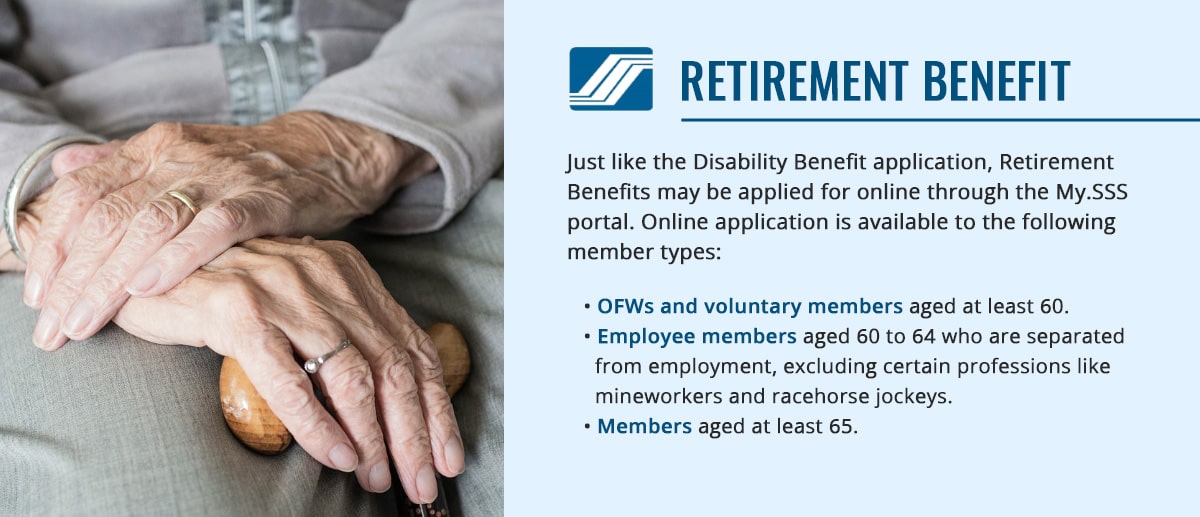
All qualified employee-members, self-employed individuals, voluntary members, and land-based Overseas Filipino Worker members are required to file their retirement benefit claims online through the My.SSS portal, adhering to the guidelines outlined in Circular No. 2021-021 issued on December 28, 2021.
- OFWs and voluntary members aged at least 60.
- Employee members aged 60 to 64 who are separated from employment, excluding certain professions like mineworkers and racehorse jockeys.
- Members aged at least 65.
To file the retirement online, the retiring member must have the following prerequisites:
- Must have a registered My.SSS account.
- Must have a disbursement account enrolled in the Bank Enrollment Module.
- For monthly pension, must have at least 120 posted monthly contributions.
- For lump sum benefit, must have at least 1 posted monthly contribution.
- No cancelled or multiple SS numbers.
- No outstanding loans under specified programs, except for certain types of SSS loans.
- No dependent children.
For the following special circumstances, over-the-counter application and submission of required documents are also permitted:Member has a dependent child/children;
- Member is incapacitated, under guardianship, or confined in an applicable institution such as penitentiary, correctional institution, or rehabilitation center;
- Member is applying under Portability Law or Bilateral Social Security Agreements; or
- Member has an outstanding Stock Investment Loan Program (SILP)/Privatization Loan Program/Educational Loan/Vocational Technology Loan balance. Outstanding loan balance shall be for salary/calamity or Salary Loan Early Renewal Program (SLERP).
DEATH BENEFIT
A monthly death benefit is provided to the primary beneficiaries of the deceased member who fulfilled the requirements of at least 36 monthly contributions before the semester of their passing.
Who can claim SSS death benefit?
The death benefit may be claimed Considered as primary beneficiaries are the following:
- The dependent spouse until he or she remarries
- Not employed and unmarried dependent children who are legitimate, legitimated, or legally adopted, and illegitimate below 21 years old.
Alternatively, a lump sum amount is given to beneficiaries of the deceased member with fewer than 36 monthly contributions before their passing. In cases when no primary beneficiaries exist, the member’s secondary beneficiaries, such as dependent parents, shall receive the lump sum amount.
Should there be no secondary beneficiaries, the lump sum amount is granted to designated beneficiaries and legal heirs.
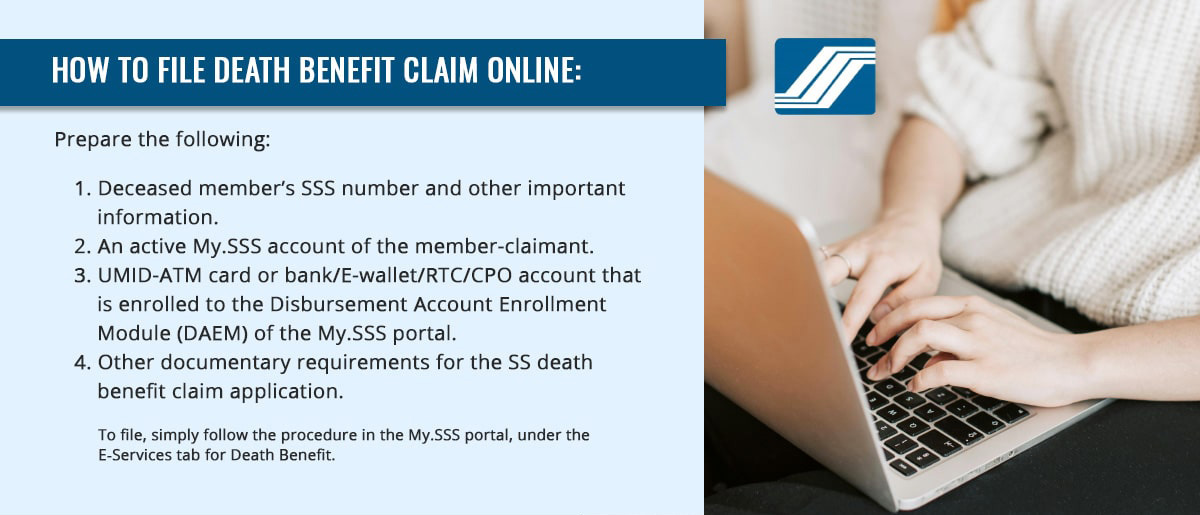
How to file SSS death benefit online
Prepare the following:
- Deceased member’s SS number and other important information.
- An active My.SSS account of the member-claimant.
- UMID-ATM card or bank/E-wallet/RTC/CPO account that is enrolled to the Disbursement Account Enrollment Module (DAEM) of the My.SSS portal.
- Other documentary requirements for the SS death benefit claim application.
To file, simply follow the procedure in the My.SSS portal, under the E-Services tab for Death Benefit.
What documents are needed for an SSS death claim?
- PSA birth certificate of deceased member
- PSA marriage certificate of deceased member
- PSA death certificate of deceased member
- Baptismal certificate may be submitted if birth certificate is not available
- Other documents that the SSS may require.
FUNERAL BENEFIT
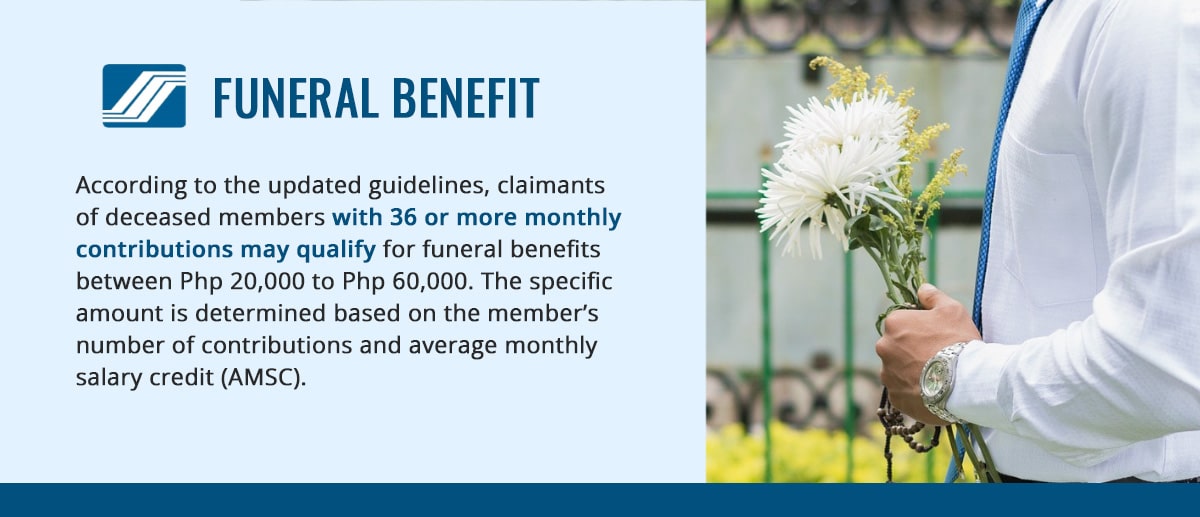
Recently, the SSS announced that they are raising the maximum funeral benefit amount to Php 60,000. According to the updated guidelines, claimants of deceased members with 36 or more monthly contributions may qualify for funeral benefits between Php 20,000 to Php 60,000. The specific amount is determined based on the member’s number of contributions and average monthly salary credit (AMSC).
Priority is given to surviving legal spouses in the allocation of funeral benefits. Additionally, funeral benefit applications must be filed within 10 years from the month of the member’s or pensioner’s death. The filing process requires SSS member-claimants to submit applications online through their My.SSS account, while non-member claimants can apply at any SSS branch.
What are the requirements for an SSS funeral claim?
The surviving legal spouse-claimant has the option to provide the following documents instead of an Official Receipt as evidence of their payment of funeral expenses for the deceased spouse:
- PSA marriage certificate
- LCR or MCR copy of marriage certificate (if PSA copy is not available)
- National Commission on Indigenous Peoples (NCIP) if deceased member or pensioner is an Indigenous People.
- Shari’a Circuit Clerk of Court if deceased member or pensioner is Muslim.
- Duly notarized affidavit or online certification stating that they paid for the funeral expenses.
-
If the claimant is other than the surviving legal spouse, the following conditions shall apply:
- Official Receipt of payment issued under the name of the claimant and indicating the name of the deceased member or pensioner.
- If a memorial plan or funeral insurance was used for the deceased member’s wake and burial, present a Certification of Availment of the memorial plan. The plan must have been paid by the member or pensioner before their death.
-
The proof of payment must be submitted with the following:
- A duly notarized waiver, favoring the claimant, signed by the surviving legal spouse, or
- A duly notarized affidavit, validated by two impartial witnesses, affirming that either the surviving legal spouse did not cover the funeral expenses or is untraceable.
How do I claim a funeral benefit?
Funeral benefit claims may be filed online by SSS members or over the counter if the claimant is not an SSS member.
To file a funeral benefit claim online through the My.SSS portal, you must:
- Be an SSS Member: You must have an assigned Social Security number and be registered on the SSS website.
- Have a Disbursement Account: You need to have a designated disbursement account enrolled in the Disbursement Account Enrollment Module (DAEM) of the My.SSS portal.
- No Longer Need a UMID Card: Having an SSS Unified Multi-Purpose ID (UMID) or a digitized ID, or even applying for one, is no longer a requirement for online filing.
The complete instructions and list of requirements when filing a Funeral Benefit claim over the counter (for non-SSS members and non-relatives of the deceased) can be found in the official website of the SSS.
UNEMPLOYMENT BENEFIT
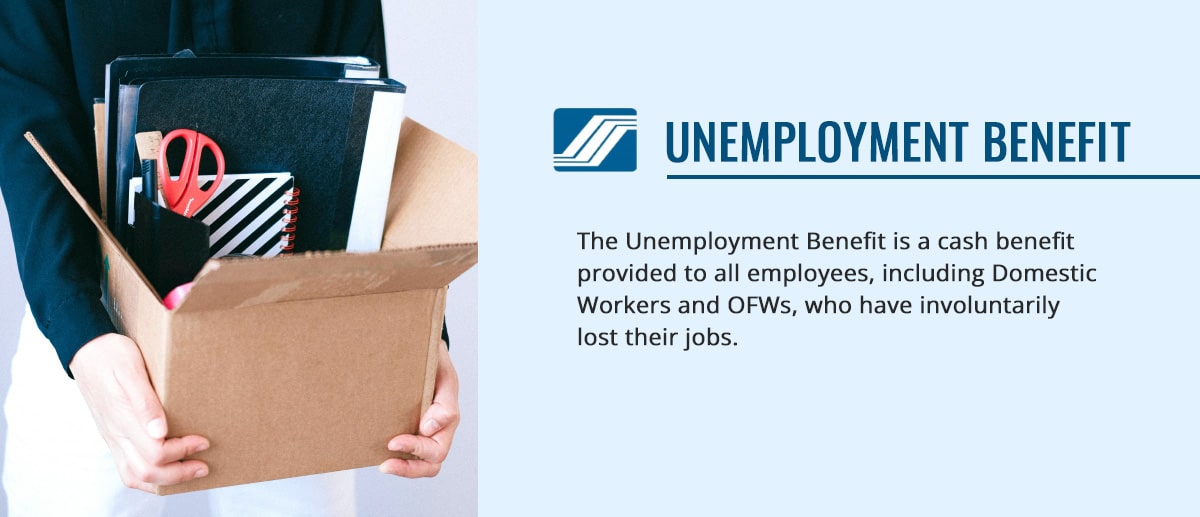
The Unemployment Benefit is a cash benefit provided to all employees, including Domestic Workers and OFWs, who have involuntarily lost their jobs.
Who is qualified for unemployment benefits?
To qualify for unemployment benefits under the SSS, the claimant must meet the following conditions. This includes private employees, domestic workers, or OFWs:
- Must not exceed 60 years of age upon employment, except: if an underground or surface mineworker, must not exceed 50 years old, or if a racehorse jockey, must not exceed 55 years old.
- Must have paid at least 36 monthly contributions, with 12 of these made within the 18 months prior to the month of involuntary job loss.
- Must not have received an unemployment benefit within the last three years prior to the month of involuntary job loss.
-
Lost the job due to, but not limited to, the following:
Authorized causes of termination under Article 298 (283) and 299 (284) of Presidential Decree No. 442 or the Labor Code of the Philippines, such as:
- Use of labor-saving devices
- Redundancy
- Reduction of workforce.
An employee is ineligible for the benefit if they were involuntarily separated from employment due to any of the following reasons:
- Serious misconduct
- Willful disobedience to lawful orders
- Gross and habitual neglect of duties
- Fraud or willful breach of trust/loss of confidence
- Commission of a crime or offense
- Analogous cases such as abandonment, gross inefficiency, disloyalty, conflict of interest, or dishonesty.
How to apply for SSS Unemployment Benefits?
The Unemployment Benefit may be applied for by qualified SSS members online through the My.SSS portal. After logging in as a Member, go to the E-Services tab and click the Apply for Unemployment Benefit link.
In navigating life’s uncertainties, having access to reliable financial support is essential. The Social Security System (SSS) offers this support to Filipinos when needed most. My.SSS, our online portal, simplifies access to benefits, making processes smoother. Keeping vital documents updated, like PSA certificates, is crucial for easy claim filing. Ensuring you have an active My.SSS account and keeping all your documents updated is essential for planning ahead and being prepared for whatever life may bring.
If you need a copy of your PSA birth certificate, you can simply order it online and have it delivered to you. Visit www.PSAHelpline.ph and click the Order Now button to get started. You can also choose to have your PSA birth certificate conveniently delivered to a National Book Store branch near you. This allows you to pick it up at your own pace, fitting your schedule perfectly. To ensure the participating National Book Store closest to you offers this service, simply visit the website's FAQs page for a complete list of participating branches.
Additional SSS Programs and Services
Beyond the core benefits, the SSS also offers several programs designed to assist members with their financial needs:
- Salary Loan Program: A quick and accessible loan facility for active members with a minimum number of contributions. This helps members cover emergency expenses or personal needs.
- Calamity Loan: Assistance for members affected by natural disasters, providing loans with flexible payment terms to help rebuild.
- Educational Assistance Loan Program: Support for members who want to finance the education of their children or dependents.
- Short-Term Member Relief Programs: Temporary benefits or aid during extraordinary circumstances, such as pandemics or emergencies.
Most of these programs can be applied for through the My.SSS portal, making it easier to access financial help without the need to visit physical offices.
SSS Benefit Claim Checklist
To help you prepare for filing any SSS benefit claims, here is a consolidated checklist of essential documents you may need:
- Valid IDs: SSS ID, UMID card, or any government-issued primary ID such as driver’s license or passport.
- Medical Certificates: Depending on the benefit, such as sickness or maternity certificates from attending physicians.
- PSA Documents: Birth certificate, death certificate, or marriage certificate from the Philippine Statistics Authority (PSA). Ordering these through PSA online services like PSAHelpline.ph can speed up your claim process.
- Benefit Application Forms: Available at the SSS branch or downloadable from the My.SSS portal.
- Authorization Letters: If you are filing through a representative, a signed authorization letter may be required.
Having all documents prepared and verified before submission helps avoid delays and ensures smooth processing of your benefits.
Frequently Asked Questions (FAQs)
Can I claim SSS benefits without a PSA birth certificate?
In most cases, a PSA birth certificate is a key document for verifying your identity and eligibility. Some benefits may require it explicitly, so it is highly recommended to have an updated PSA birth certificate ready.
How long does it take to process SSS claims?
Processing times vary depending on the benefit type and submission method but typically range from a few days to a few weeks. Filing through the My.SSS online portal often speeds up the process.
Can OFWs claim SSS benefits online?
Yes. Overseas Filipino Workers can file for benefits online through My.SSS and submit required documents electronically.
How do I correct my PSA birth certificate details?
If you discover errors in your PSA birth certificate, visit the Local Civil Registry Office where your birth was registered for a consultation. Their staff will guide you on the appropriate steps to take next.
What if I lost my PSA birth certificate?
You can request a copy of your birth certificate online via PSAHelpline.ph with options for delivery or pick-up.
What IDs are accepted for SSS claims?
Primary IDs such as SSS ID, UMID, passport, driver’s license, voter’s ID, NBI clearance, and postal ID are accepted.
Where can I get quick PSA delivery and birth certificate online?
Visit PSAHelpline.ph for secure and fast ordering of PSA certificates with door-to-door and pick-up delivery options.
How PSA Online Ordering Supports SSS Claims
Many SSS benefit claims require official civil registry documents, with the PSA birth certificate being among the most frequently requested.
Now, with PSA online ordering services such as PSAHelpline.ph, you can conveniently order your PSA certificate online from home. This platform offers:
- Birth certificate delivery straight to your doorstep or to nearby National Book Store and Robinsons Department Store branches for convenient pick-up.
- Easy-to-use online forms and multiple payment options.
- Secure processing that ensures your personal data remains protected.
By having your PSA birth certificate ready and updated, you can prevent delays in your SSS claims, making the process faster and less stressful.
Conclusion
The Social Security System (SSS) remains a cornerstone of social protection for Filipinos, offering a comprehensive safety net for various life events—from sickness and maternity to retirement and unforeseen unemployment. Understanding the full range of benefits available empowers members to plan effectively for their future.
However, having access to these benefits also means being prepared with the right documentation. The PSA birth certificate and other civil registry documents are critical components of your claim requirements. Leveraging PSA online services like PSAHelpline.ph ensures you can obtain these documents efficiently through birth certificate delivery services that suit your convenience.
Furthermore, the My.SSS online portal offers Filipinos a seamless way to manage their benefits anytime and anywhere, minimizing the need for in-person visits. By combining SSS membership with up-to-date PSA documents, you create a streamlined path to secure your rightful benefits without unnecessary delays.
Stay proactive: maintain your contributions, keep your personal records current, and familiarize yourself with online tools that make claiming benefits easier. Life can be unpredictable, but with SSS and PSA online services, you can be ready to face whatever comes your way with confidence and peace of mind.
About PSAHelpline.ph
At PSAHelpline.ph, we simplify the process of requesting PSA certificates online. Our blogs offer step-by-step guides, the latest updates, and practical tips to help you avoid common mistakes when handling PSA online appointments or ordering your certificates.
As an authorized PSA partner for over 25 years, we’ve assisted millions of Filipinos in securely obtaining their PSA birth certificates, marriage certificates, and other civil registry documents.
Known for the fastest PSA delivery, we prioritize accuracy and are fully compliant with the Data Privacy Act of 2012, ensuring your personal information is always protected.
Why You Can Rely on Us
We deliver reliable, organized, and up-to-date information for every PSA online transaction. Our content is thoroughly researched and updated regularly, making us a trusted guide for all PSA certificate online requests.
